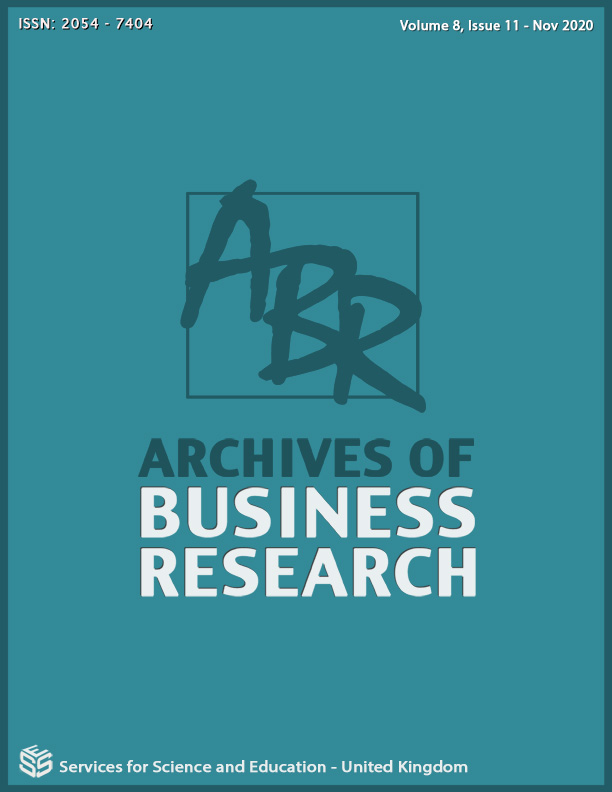Analysis of Mobile Financial Services Utilization among Small Scale Businesses in Kiambu County, Kenya
DOI:
https://doi.org/10.14738/abr.811.9385Keywords:
Mobile financial services, Random Utility Model, utilization, rural areas, small scale businesses, financial inclusionAbstract
This study examined the level of utilization of Mobile financial services among small scale businesses in Kiambu County. Primary data was obtained through interview administered questionnaire from 123 small scale businesses in Kiambu County. Using descriptive analysis the study found out that 48.8 percent of the businesses utilized mobile financial services. The mobile financial services utilized by the businesses included mobile money in phone, Pay bill Buy goods and services and mobile money bank accounts. Majority of the businesses used mobile money in phone. Businesses cited lack of mobile financial services devices by businesses, lack of mobile financial services incentives such as loyalty points, mobile money transaction charges, poor interoperability between networks, low acquaintance to mobile financial services transactions, service system breakdown, difficulties while accessing customer care services as major challenges in use of mobile financial services. The study concludes that mobile financial services are compliments other financial services in extending financial services to the unbanked sector in the county and recommends that systems development and improvement of service delivery by mobile network operators towards small scale businesses and enhanced legislations on data protection and cyber-crimes to protect users of mobile financial services towards increased use of the services.
References
[2]. Communication Authority of Kenya (2020).Third Quarter Sector Statistics Report for the Financial Year 2019/2020 (January – March 2020).Nairobi, Kenya. Government printer. Retrieved from www.ca.go.ke
[3]. Republic of Kenya (2020). Fourth quarter sector statistics report for the financial year 2019/2020. (April – June 2020).Nairobi, Kenya. Government printer
[4]. Kenya, Financial Sector Deepening (2016). FinAccess household survey. Nairobi: FSD Kenya.
[5]. World Bank (2019). World Development Indicators. Washington, DC: The World Bank. Retrieved from https://databank.world.org
[6]. Central Bank of Kenya, Kenya National Bureau of Statistics & FSD Kenya (2019). FinAccess Household Survey on financial access and usage in Kenya. Nairobi, Kenya: FSD Kenya.
[7]. Nyaga, K. M. (2013). The impact of mobile money services on the performance of small and medium enterprises in an urban town in Kenya. Unpublished Project. KCA University.
[8]. Kenya, Financial Sector Deepening (2019). FinAccess household survey. Nairobi: FSD Kenya.
[9]. Dwivedi, D. N. (2016). Microeconomics: Theory and Applications (3rd Ed). New Delhi, India. Vikas Publishing House.
[10]. Block, H. D., & Marschak, J. (1960). Contributions to probability and statistics: Random Orderings and Stochastic Theories of Responses. California, United States of America. Stanford University Press.
[11]. Morawczynski, O., & Pickens, M. (2009). Poor people using mobile financial services: observations on customer usage and impact from M-PESA. Washington, DC: World Bank. Retrieved from http://documents.worldbank.org
[12]. Ndunge, K., & Mutinda, J. (2012). Mobile Money Services and Poverty Reduction: A Study of Women Groups in Rural Eastern Kenya. Institute for Money, Technology and Financial Inclusion (IMTFI). Working Paper 2011, 12.
[13]. Maradung, P. (2013). Factors affecting the adoption of mobile money services in the banking and financial industries of Botswana. Unpublished project. North West University.
[14]. Muriuki, N. G. (2014). The role of mobile phone use in the success of small and medium sized enterprises: A case of SMES providing financial services in the Kiambu sub County, Kenya. Unpublished project. University of Nairobi.
[15]. Mutisya, R. (2016) The Role of mobile banking on the growth of micro and small enterprises in Kitui County, Kenya .Unpublished project. University of Nairobi.
[16]. Chebet, E. R. (2017). The Impact of Mobile Payments On The Performance Of Micro-Businesses: A Case Of Safaricom Lipa Na M-Pesa Services In Machakos Town, Kenya. Unpublished project. University of Nairobi.
[17]. Mararo, M. W. (2018). Influence of mobile money services on the growth of SME in Nakuru town Kenya .Unpublished project. JKUAT
[18]. Republic of Kenya (2015). County Statistical Abstract Kiambu County. Nairobi. Government Printer. Retrieved from www.knbs.or.ke






